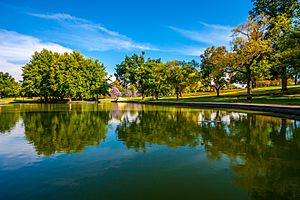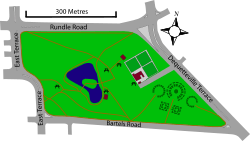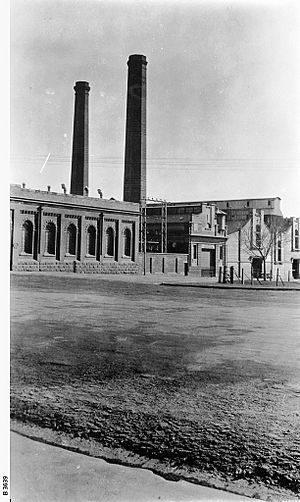Rymill Park facts for kids
Rymill Park is also known by its Kaurna name, Murlawirrapurka. It's called Park 14 and is a fun place in the East Park Lands of Adelaide, South Australia. This park has a cool artificial lake where you can rent rowboats. There's also a café, a children's playground, and a beautiful rose garden. The Adelaide Bowling Club is located on one side of the park. You might not see it, but the O-Bahn bus tunnel actually runs right underneath the park!
Rymill Park is a popular spot for many exciting events. It hosts parts of the Adelaide Fringe, Feast, and Festival of Arts. You can also find events like Carnevale in Adelaide and the Adelaide International Horse Trials here. During the Fringe Festival, a special area on the western side of the park is set up and called Gluttony.
Contents
What's in Rymill Park?
Rymill Park is surrounded by East Terrace, Dequetteville Terrace, Rundle Road, and Bartels Road. It's close to the Adelaide Botanic Garden, Hutt Street, Rundle Park, and Victoria Park.
Fun Activities and Features
You can rent rowboats at the park's kiosk to use on the lake. The kiosk, now called "Loch & Quay," reopened in late 2018.
The park also has lovely rose gardens, playgrounds for kids, and many old, tall trees. There are barbecue areas perfect for picnics. You'll find a statue of Alice from Lewis Carroll's famous stories, which was put there in 1962. This statue was created by an artist named John Dowie. Near the playground, there's also a drinking fountain designed by Dowie.
The park is a busy place for many cultural and sports events. These include Carnevale in Adelaide, the Adelaide International Horse Trials, and various events from the Adelaide Festival, Adelaide Fringe, and Feast festivals. The Fringe Festival area in Rymill Park is known as "Gluttony."
Park History and Development
Early Days of the Park Area
Long before European settlers arrived, the eastern parklands were used by the Kaurna people as a place to meet and camp. In the late 1800s, Poltpalingada Booboorowie, a Ngarrindjeri man known as Tommy Walker, and other Aboriginal people sometimes camped in this area. Later, they were asked to move, first to the Adelaide Botanic Garden area and then to Glenelg.
How Rymill Park Was Created (1960)
For many years, the area where Rymill Park now stands was described as "bare" and "swampy" in winter. This was true from the time Colonel Light first planned Adelaide and its parklands.
The Adelaide Bowling Club moved to its current spot in the park in 1958. In 1959–1960, the Adelaide City Council made big improvements to the park. The Town Clerk, William Veale, suggested building an artificial lake, a playground, and a picnic area after a trip overseas. These new features were officially opened in late 1960.
The park was named after Sir Arthur Rymill. He was the Lord Mayor of Adelaide from 1950 to 1954 and a council member for 23 years. He strongly supported making Adelaide's parklands better. The lake was built in 1959, and the rose gardens were created in the 1960s by digging up what used to be the Bartels Road rubbish tip.
Giving the Park a Dual Name (2003)
In 1997, the Council decided to add Kaurna names to many city places. They worked with Kaurna authorities to choose the right names. In 2003, Rymill Park was also given the name Mullawirraburka. This name belonged to a Kaurna man known to settlers as "King John." His name came from Kaurna words: mulla (dry) and wirra (forest), which together formed Mullawirra, a territory he inherited. Burka means "old man."
Lake Repairs (2008)
The park's lake had a leak, losing about 200,000 liters of water each week. So, in November 2007, the lake was drained for repairs. It was refilled in September 2008, ready for everyone to enjoy again.
O-Bahn Tunnel Extension (2015–2017)
In 2015, there was a plan to extend the O-Bahn bus services into the city. This plan involved building a tunnel under Rymill Park and nearby Rundle Park. Some people were concerned because it meant removing many old trees. However, the construction went ahead and was finished in December 2017.
Plants and Animals in the Park
Many of the large trees in Rymill Park have hollows and branches where different animals can live and nest. You can often see native birds like crested pigeons, magpies, magpie-larks, eastern rosellas, rainbow lorikeets, Australian white ibis, and various types of ducks.
Ducks are always present at the artificial lake, which provides a constant water source for them. The most common ducks you'll see are Pacific black ducks and Australian wood ducks.
You might also spot marsupials like the brushtail possum. They rest in tree hollows during the day and come out at night to find food.





